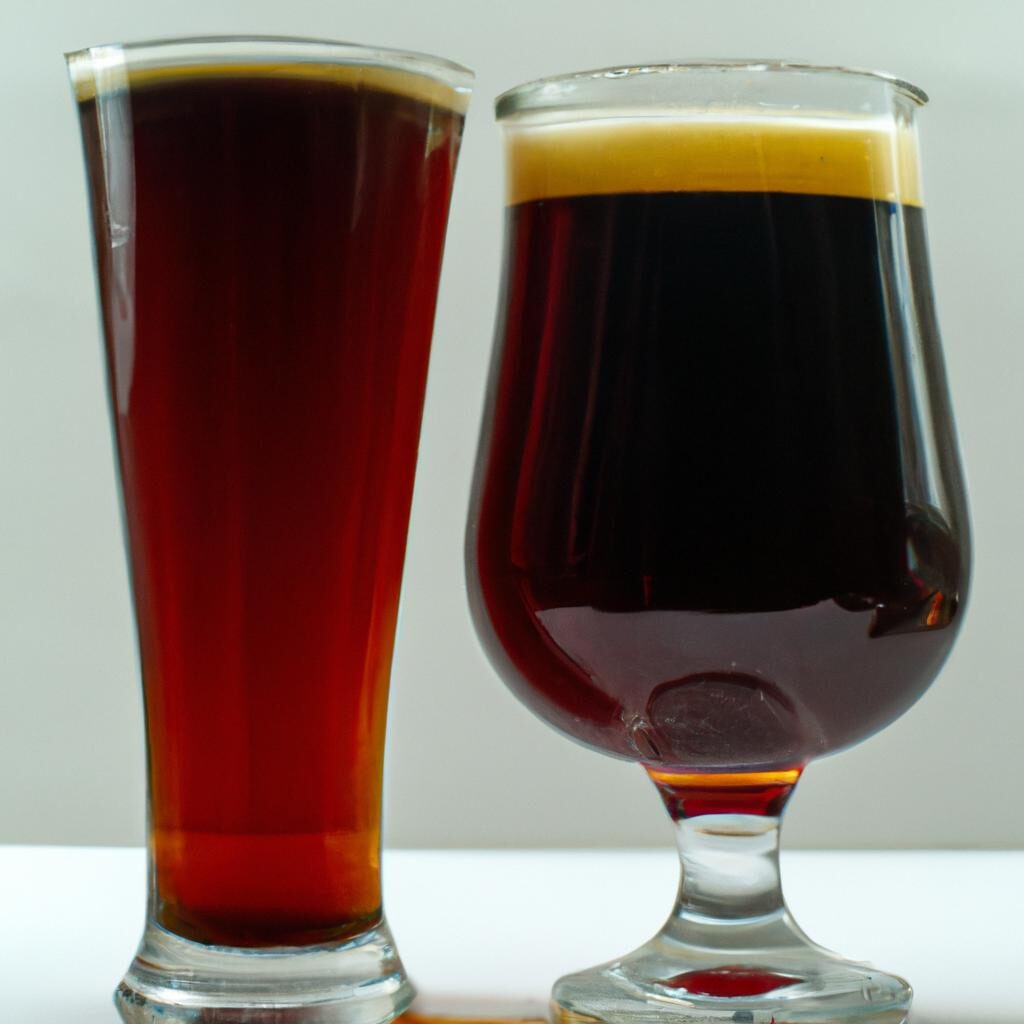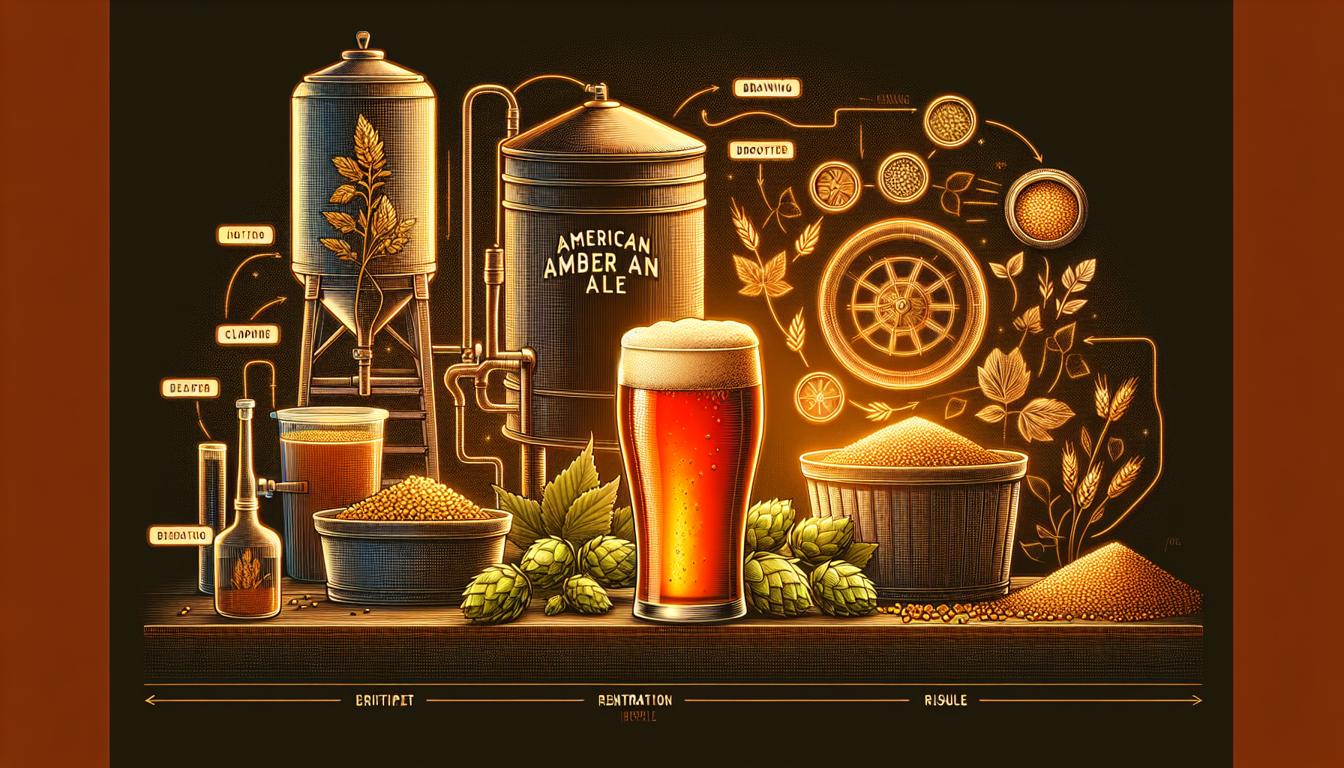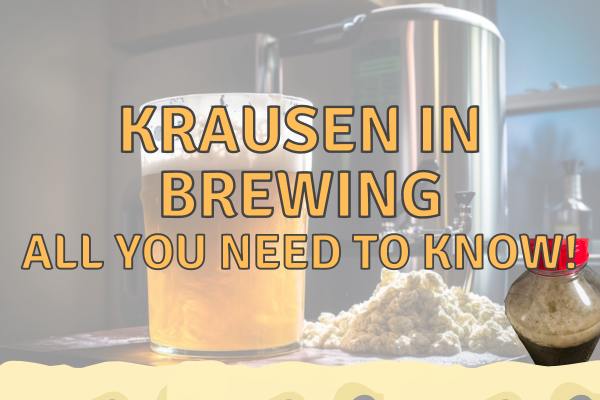Welcome to my humble brewing abode! Today, I want to take you on a journey through the brewing process of a classic American Amber Ale. This beer style holds a special place in my heart, as it perfectly combines the rich maltiness of an English ale with the hop-forward characteristics of an American craft beer. So grab a pint glass, sit back, and let’s dive into the world of American Amber Ales!
A Brief History and Key Characteristics
The American Amber Ale style emerged in the United States during the craft beer revolution of the 1980s. Inspired by the English Bitter and Pale Ale styles, American brewers sought to put their own spin on these classic beers by incorporating the bold hop flavors that had become synonymous with American craft brewing.

American Amber Ales typically have a moderate to high hop bitterness, balanced by a robust malt backbone. The color ranges from deep amber to a reddish-copper hue, giving the beer its distinctive appearance. The aroma is a harmonious blend of caramel, toffee, and toasted malt notes, with a hint of floral or citrus hop character. It’s a beer that offers complexity and drinkability in equal measure.
The Amber Ale Recipe
Now, let’s get down to business and craft our own American Amber Ale. Here’s a recipe that I’ve refined over the years, resulting in a beer that consistently hits the mark:
Ingredients:
- 10 lbs (4.5 kg) Pale Ale Malt
- 1 lb (0.45 kg) Crystal 60 Malt
- 8 oz (227 g) Victory Malt
- 4 oz (113 g) Chocolate Malt
- 1 oz (28 g) Cascade Hops (60 minutes)
- 1 oz (28 g) Centennial Hops (15 minutes)
- 1 oz (28 g) Cascade Hops (5 minutes)
- 1 oz (28 g) Centennial Hops (Dry Hop)
- American Ale Yeast
- 5 oz (142 g) Priming Sugar for bottling
Instructions:
1. Start by heating 3 gallons (11 liters) of water in your brew kettle to around 160°F (71°C). This will serve as your strike water.
2. Meanwhile, mill your grains and add them to a muslin bag or a grain basket. Once your strike water reaches the desired temperature, carefully add the grains and stir gently to ensure even distribution.
3. Allow the grains to steep for 60 minutes, maintaining a temperature between 150°F and 155°F (66°C and 68°C). This will extract the sugars from the malt, giving your beer its characteristic sweetness.
4. After the mash is complete, remove the grain bag or basket and allow the excess liquid to drain back into the kettle. You can give it a gentle squeeze, but be careful not to extract any tannins from the grain husks.
5. Bring the wort to a boil and add the Cascade hops. Set your timer for 60 minutes and let the hop bitterness develop. Remember, the hops are the star of the show in an American Amber Ale, so don’t be shy!
6. At the 15-minute mark, add the Centennial hops to infuse some additional hop flavor. This will contribute to the overall complexity of the beer.
7. With just 5 minutes left in the boil, toss in another round of Cascade hops. This late addition will lend a burst of hop aroma to your finished beer.
8. After the boil is complete, cool the wort rapidly using a wort chiller or an ice bath. Aim for a temperature around 70°F (21°C) before transferring to your fermenter.
9. Once the wort is in the fermenter, pitch your American Ale yeast and seal it up tight. Fermentation should take place at a temperature between 65°F and 70°F (18°C and 21°C) to ensure optimal yeast activity.
10. After about a week, it’s time to dry hop your beer. Add the Centennial hops directly to the fermenter, allowing them to infuse their hoppy goodness for another 5-7 days.
11. Finally, it’s bottling time! Dissolve the priming sugar in a small amount of boiling water and add it to your beer. This will provide the carbonation necessary for a lively pint.
12. Fill your bottles, cap them tightly, and let them condition for at least two weeks. This will allow the flavors to meld and the carbonation to fully develop.
Expert Tips and Advice
Brewing an American Amber Ale is not just about following a recipe; it’s about understanding the nuances of the style and making it your own. Here are a few expert tips and personal anecdotes to help you on your brewing journey:
– Malt Selection: The malt bill is the backbone of any beer, and American Amber Ales are no exception. Experiment with different specialty malts to find the perfect balance of caramel, toffee, and toastiness. I’ve found that the combination of Crystal 60, Victory, and Chocolate malts creates a wonderfully complex base for this style.
– Hop Varieties: While Cascade and Centennial hops are the classic choices for an American Amber Ale, don’t be afraid to explore other hop varieties. Amarillo, Simcoe, or even Citra hops can add a unique twist to your beer and elevate it to new heights.
– Water Chemistry: Pay attention to your water chemistry when brewing this style. A slightly higher sulfate-to-chloride ratio can accentuate the hop bitterness and enhance the overall flavor profile.
– Fermentation Temperature: Controlling the fermentation temperature is crucial for achieving the desired flavor profile. Too warm, and your beer can develop off-flavors; too cold, and the yeast may become sluggish. Find a comfortable spot for your fermenter, and consider using a temperature-controlled fermentation chamber if you’re serious about taking your brewing to the next level.
– Patience is a Virtue: American Amber Ales are at their best when given time to age and condition. Don’t rush the process; let the flavors meld and evolve over time. Trust me, it’s worth the wait.
Conclusion
Brewing an American Amber Ale is a labor of love that combines the best of both worlds: the malt complexity of traditional English ales and the bold hop character of American craft beers.
By paying attention to the malt bill, hop selection, water chemistry, fermentation temperature, and patience, you can create a beer that is uniquely your own.
So, my fellow brewing enthusiasts, raise your glasses high and toast to the art of brewing a perfect American Amber Ale. May your brew days be filled with joy, your fermenters overflow with creativity, and your pints be forever tasty. Cheers!
FAQs
How long does it take to ferment American Amber Ale?
The fermentation process for American Amber Ale typically takes around 1-2 weeks. However, it is important to note that the exact duration can vary depending on factors such as yeast strain, fermentation temperature, and desired flavor profile. It is recommended to monitor the specific gravity and taste of the beer to determine when fermentation is complete.
What is the best grain for amber ale?
The best grain for amber ale is usually a combination of base malts such as pale malt or Maris Otter, along with specialty malts like caramel or crystal malts. This combination helps to achieve the rich, amber color and malty flavor profile characteristic of the style.
What hops are best for amber ale?
Some popular hop varieties that work well in amber ales include Cascade, Willamette, Centennial, and Fuggles. These hops provide a balanced flavor profile with notes of citrus, floral, and earthy characteristics that complement the maltiness of an amber ale. Ultimately, the choice of hops depends on personal preference and desired flavor profile.
What makes a good amber ale?
A good amber ale typically has a balanced combination of malt sweetness and hop bitterness. It should have a rich amber color, medium body, and a smooth mouthfeel. The malt flavors can range from caramel and toffee to biscuit and toasted bread, while the hop flavors should be present but not overpowering. A good amber ale should also have a clean finish with a moderate level of carbonation.
What is the best yeast for amber ale?
The best yeast for amber ale would depend on the specific flavor profile desired. However, a popular choice is an American Ale yeast, such as Wyeast 1056 or White Labs WLP001, as it produces clean and balanced flavors that complement the maltiness and hop character of an amber ale.
What brands of beer are amber ale?
Some popular brands of amber ale include Fat Tire Amber Ale, Alaskan Amber, Bell’s Amber Ale, and New Belgium Brewing’s 1554.





Leave a Reply
You must be logged in to post a comment.